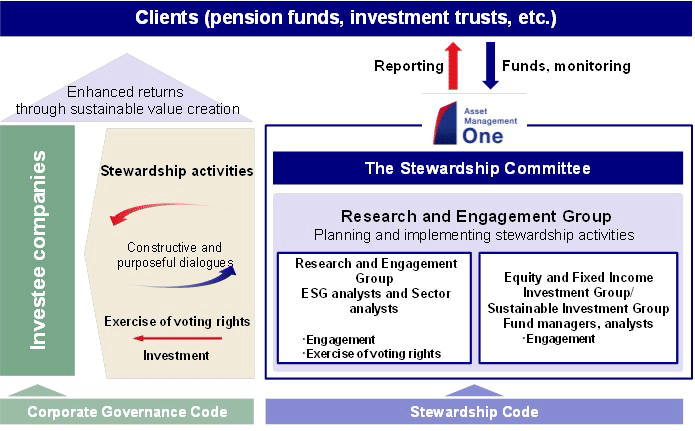Stewardship responsibilities and ESG investment
Initiatives at Asset Management One
At the same time that Asset Management One, which is the Mizuho group company responsible for asset management, began operations in October 2016, we newly established our Responsible Investing Department (currently Research and Engagement Group) and proceeded with initiatives for active engagement in discussions with our investee companies regarding environmental, social, and corporate governance (ESG) issues and exercise of proxy voting rights.
Asset Management One's corporate message "Creating a sustainable future through the power of investment" clearly states that it will "incorporate sustainability into management" as an asset management company contributing to customers and society. Asset Management One created a materiality map that dynamically captures global environmental and social issues based on two axes (double materiality) of sustainable materiality, which indicates the level of civil society and investor interest, and financial materiality, indicating the economic impact. Management also identified nine core materiality items of climate change, biodiversity, business and human rights, water resources, circular economy, diversity equity and inclusion, sustainable food systems, air, water and land pollution, and health and wellbeing. Of these, business and human rights, diversity and inclusion, and health and wellbeing were set as focus areas, that the company will use to guide its engagement and voting related to its materiality items.

Approach to engagement activity
Asset Management One’s Engagement Approach (PDF/54KB)
Actual engagement activities
Engagement Activities with Japanese Companies (PDF/124KB)
Engagement Activities with Overseas Companies (PDF/47KB)
Examples of engagement
Our engagement activity – examples for Japanese equity passive strategies (PDF/293KB)
Engagement Case Study with an Overseas Company (PDF/62KB)
Development of products with a view to ESG
In recent years, institutional investors have been showing greater interest in ESG investment, which considers environmental, social, and corporate governance (ESG) issues, as a type of non–financial information. To continue to be an asset management institution that contributes to the development of our customers and society as a whole, Asset Management One recognizes the importance of ESG information as a foundation for financial information in the medium to long term, and we are working to integrate ESG into our investment strategies.
ESG Japan Equity Strategy
The domestic ESG Focus Fund is an ESG investment product that reflects our vision of sustainable investment products.
Conceptually, it aims to achieve sustainable financial returns and contribute to social returns including in the form of the planet or society passed onto the next generation, by investing in companies serving as drivers of a sustainable society. To that end, we have built an investment strategy integrating the following three features.
①Evaluation of promising industries based on a double materiality approach
Based on our proprietary Materiality Map, we identify and evaluate promising industries with growth potential, and leverage ESG Rating, our proprietary tool for business evaluation, to select companies with business practices capable of rapidly responding to societal demand for sustainability.
②Identification of business opportunities and evaluation of management quality by ESG experts
Building on the industrial evaluation based on the Materiality Map, the ESG Macro-Research and ESG Quantitative Analysis Teams, both composed of specialists in ESG, conduct research to identify "companies involved in business to help solve environmental and social issues" and "companies with high ESG potential" as candidates for investment. Those companies are subsequently assessed for suitability as investment targets in terms of profit sustainability and valuation, among others. Only those companies that are expected to produce substantial returns on capital over the years are retained in the portfolio.
③Engagement with investment targets leveraging our strong presence
Our sector analysts and ESG analysts work together to engage with the target companies in order to ensure that the latter continue to improve their ESG potential.